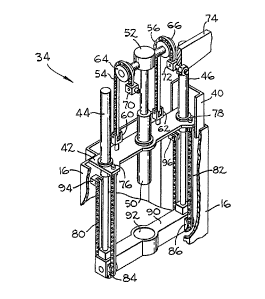Some of the information on this Web page has been provided by external sources. The Government of Canada is not responsible for the accuracy, reliability or currency of the information supplied by external sources. Users wishing to rely upon this information should consult directly with the source of the information. Content provided by external sources is not subject to official languages, privacy and accessibility requirements.
Any discrepancies in the text and image of the Claims and Abstract are due to differing posting times. Text of the Claims and Abstract are posted:
| (12) Patent: | (11) CA 1267105 |
|---|---|
| (21) Application Number: | 542040 |
| (54) English Title: | REAR PLATFORM LIFT |
| (54) French Title: | ELEVATEUR POUR PLATE-FORME ARRIERE |
| Status: | Deemed expired |
| (52) Canadian Patent Classification (CPC): |
|
|---|---|
| (51) International Patent Classification (IPC): |
|
| (72) Inventors : |
|
| (73) Owners : |
|
| (71) Applicants : | |
| (74) Agent: | SIM & MCBURNEY |
| (74) Associate agent: | |
| (45) Issued: | 1990-03-27 |
| (22) Filed Date: | 1987-07-14 |
| Availability of licence: | N/A |
| (25) Language of filing: | English |
| Patent Cooperation Treaty (PCT): | No |
|---|
| (30) Application Priority Data: | ||||||
|---|---|---|---|---|---|---|
|
Abstract of the Disclosure
An aircraft loader has an elevatable deck supported on
scissor-type supports and urged into the elevated position by a
hydraulically actuated lifting structure. The lifting structure
incorporates two supports that move vertically on chain members when the
cylinders are actuated.
Note: Claims are shown in the official language in which they were submitted.
Note: Descriptions are shown in the official language in which they were submitted.

For a clearer understanding of the status of the application/patent presented on this page, the site Disclaimer , as well as the definitions for Patent , Administrative Status , Maintenance Fee and Payment History should be consulted.
| Title | Date |
|---|---|
| Forecasted Issue Date | 1990-03-27 |
| (22) Filed | 1987-07-14 |
| (45) Issued | 1990-03-27 |
| Deemed Expired | 2000-03-27 |
There is no abandonment history.
| Fee Type | Anniversary Year | Due Date | Amount Paid | Paid Date |
|---|---|---|---|---|
| Application Fee | $0.00 | 1987-07-14 | ||
| Registration of a document - section 124 | $0.00 | 1987-09-28 | ||
| Maintenance Fee - Patent - Old Act | 2 | 1992-03-27 | $100.00 | 1992-02-17 |
| Maintenance Fee - Patent - Old Act | 3 | 1993-03-29 | $100.00 | 1993-02-25 |
| Maintenance Fee - Patent - Old Act | 4 | 1994-03-28 | $100.00 | 1994-02-14 |
| Maintenance Fee - Patent - Old Act | 5 | 1995-03-27 | $150.00 | 1995-02-10 |
| Maintenance Fee - Patent - Old Act | 6 | 1996-03-27 | $150.00 | 1996-02-16 |
| Maintenance Fee - Patent - Old Act | 7 | 1997-03-27 | $150.00 | 1997-02-12 |
| Maintenance Fee - Patent - Old Act | 8 | 1998-03-27 | $150.00 | 1998-02-05 |
Note: Records showing the ownership history in alphabetical order.
| Current Owners on Record |
|---|
| FMC CORPORATION |
| Past Owners on Record |
|---|
| STURTZ, CHARLES R. |